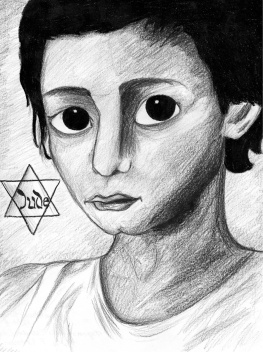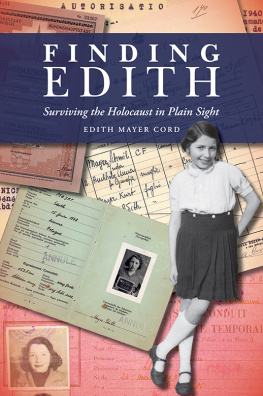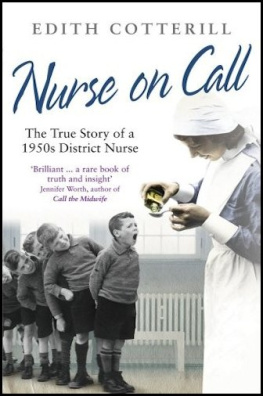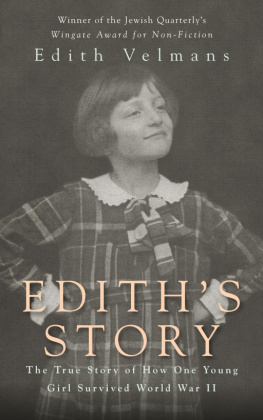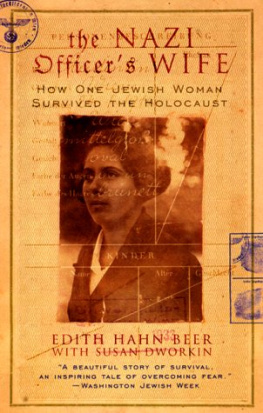Kacer - Hiding Edith a true story
Here you can read online Kacer - Hiding Edith a true story full text of the book (entire story) in english for free. Download pdf and epub, get meaning, cover and reviews about this ebook. City: France, year: 2006;2018, publisher: Second Story Press;W. Ross MacDonald School Resource Services Library, genre: Home and family. Description of the work, (preface) as well as reviews are available. Best literature library LitArk.com created for fans of good reading and offers a wide selection of genres:
Romance novel
Science fiction
Adventure
Detective
Science
History
Home and family
Prose
Art
Politics
Computer
Non-fiction
Religion
Business
Children
Humor
Choose a favorite category and find really read worthwhile books. Enjoy immersion in the world of imagination, feel the emotions of the characters or learn something new for yourself, make an fascinating discovery.

- Book:Hiding Edith a true story
- Author:
- Publisher:Second Story Press;W. Ross MacDonald School Resource Services Library
- Genre:
- Year:2006;2018
- City:France
- Rating:4 / 5
- Favourites:Add to favourites
- Your mark:
- 80
- 1
- 2
- 3
- 4
- 5
Hiding Edith a true story: summary, description and annotation
We offer to read an annotation, description, summary or preface (depends on what the author of the book "Hiding Edith a true story" wrote himself). If you haven't found the necessary information about the book — write in the comments, we will try to find it.
Kacer: author's other books
Who wrote Hiding Edith a true story? Find out the surname, the name of the author of the book and a list of all author's works by series.
Hiding Edith a true story — read online for free the complete book (whole text) full work
Below is the text of the book, divided by pages. System saving the place of the last page read, allows you to conveniently read the book "Hiding Edith a true story" online for free, without having to search again every time where you left off. Put a bookmark, and you can go to the page where you finished reading at any time.
Font size:
Interval:
Bookmark:
Hiding Edith
LIBRARY AND ARCHIVES CANADA CATALOGUING IN PUBLICATION
Kacer, Kathy, 1954
Hiding Edith / by Kathy Kacer.
(A Holocaust remembrance book for young readers)
ISBN 1-897187-06-8
ISBN 978-1-897187-06-7
1. Schwalb, Edith--Juvenile literature. 2. Jewish children in the Holocaust-
France--Biography--Juvenile literature. I. Title. II. Series: Holocaust remembrance
book for young readers.
DS135.F9S364 2006 940.5318092 C2006-900179-0
Copyright 2006 by Kathy Kacer
Second Printing 2006
Third Printing 2006
Edited by Charis Wahl
Cover and text design by Melissa Kaita
Author photograph by Nicki Kagan
The views or opinions expressed in this book and the content in which the images are used do not necessarily reflect the views or policy of, nor imply approval or endorsement by, The United States Holocaust Memorial Museum.
Every effort has been made to trace copyright holders and to obtain their permission for the use of copyright material. The publisher apologizes for any errors or omissions and would be grateful if notified of any corrections that should be incorporated in future reprints or editions of this book.
Printed and bound in Canada
Second Story Press gratefully acknowledges the support of the Ontario Arts Council and the Canada Council for the Arts for our publishing program. We acknowledge the financial support of the Government of Canada through the Book Publishing Industry Development Program.

Published by
SECOND STORY PRESS
20 Maud Street, Suite 401
Toronto, Ontario, Canada
M5V 2M5
www.secondstorypress.ca
a true story
by Kathy Kacer

In 1933, the Nazi party, led by Adolf Hitler, came to power in Germany. Hitler was a brutal dictator who believed that the German people belonged to a superior race. Therefore, his goal was to eliminate those people whom he considered inferior, particularly the Jews. He also persecuted the Roma people (then called Gypsies), the disabled, and everyone who disagreed with him. His larger aim was to conquer Europe and then the entire world.
He began his conquest by marching into Vienna, the capital of Austria, on March 12, 1938. In September 1939, Germany invaded Poland and World War II began. Before the war, Jewish communities across Europe had been strong in numbers and spirit. There were many Jewish schools, libraries, synagogues, and museums. Jewish people played an important role in the cultural life of every European country, as composers, writers, athletes, and scientists. But the war brought rules and restrictions for Jewish citizens. Jewish land was confiscated, Jews were not allowed to attend universities and colleges, were excluded from most professions, and were forced to wear the yellow Star of David on their clothing. Jews were assaulted, arrested, and their businesses taken away. Later they would be sent to prisons and concentration camps to be slave labor; there they would be starved, tortured, and killed. By the time World War II ended in 1945, it is estimated that more than six million Jewish people died or were killed at the hands of Adolf Hitler and his Nazi armies.

A star of David with the French word for Jew (Juif) printed on it.
As the war was closing in on Jewish people across Europe, many frantically fled from one country to another, trying to escape from Adolf Hitlers persecution, and trying to find a place where they might be safe. When Germany invaded northern France, some Jews sought refuge in the southern part of that country, which was known as a free zone. The town of Vichy in southern France was the location of the free zones government, under the leadership of Marshall Henri Phillipe Ptain.
The Vichy government wanted to have a good relationship with Adolf Hitler, and collaborated closely with Nazi Germany, hoping for favorable treatment in return. The Vichy regime actively persecuted Jewish people. Jews who had fled to southern France for safety were arrested and turned over to the Nazis to be sent to concentration camps. Over 75,000 Jews living in southern France were sent to the concentration camps. Of these, only about 2,500 survived the war.

Henri Phillipe Ptain
As Hitlers forces invaded country after country, terrorizing the inhabitants and searching out Jews, safe places were few. Jews became desperate, fearing for their childrens safety and their own. Many parents were forced to make a heartbreaking decision: to find someone to hide their children.
Jewish children were hidden in convents, on remote farms, in boarding schools and orphanages. Many Christian families were brave enough to take Jewish children into their own homes, even at the risk of their lives.
This was a different kind of hiding. Often the Jewish children lived openly, by concealing their identities behind new names and made-up histories where they were born, how many siblings they had, who their parents were, even what language they had first spoken. They had to be watchful every moment, taking care with whom they made friends and how they answered even the most harmless-seeming question. Many attended church, hiding their Jewish faith, learning unfamiliar customs and rituals. Always fearful, always ready to move on if danger threatened, they would stay alive only as long as they kept up their disguises.
Thousands of Jewish children survived by hiding in this way. One was Edith Schwalb. Constantly afraid, she moved from place to place, concealing her identity and hiding her faith. This is her remarkable story.

Edith Schwalb
May 1938 Vienna, Austria
Walk quickly, Edith, Papa urged. Your mother will be waiting for us with a hot lunch. We dont want to be late, do we?
Edith clutched her fathers hand tightly. But Papa had such long steps that she almost had to run to keep up. She shifted her school bag and focused on avoiding the crowds of people surging around her. Men and women rushed in all directions, buzzing like giant bees. Cars honked their horns impatiently as pedestrians darted out into traffic. The sun beat down on Ediths head, and for a moment she longed to stop and savor its warm rays on her small face.
Vienna in May was alive with flowers and birds, smells and sounds. Cafs had opened their doors, inviting customers to come in and sit down. Street vendors paraded their wares: sweet ice cream and mouth-watering chocolate; other merchants displayed newspapers and magazines. Store windows were filled with colorful summer fashions. The city had woken up like a bear after its hibernation. And Edith wanted to take it all in. But she had to keep up with Papa, and that meant she couldnt stop.
The day was so beautiful and the city so energetic that Edith hardly even thought about how scary life was becoming. No matter how young you were, you couldnt live in Vienna in 1938 and not know that Austria was becoming dangerous. Two months earlier, Germany had invaded, and Nazi soldiers had marched right through the streets of Vienna. Austrian citizens came out to cheer, waving flags with the swastika, the emblem of the Nazi army, emblazoned on them. But Jewish families like Ediths did not cheer. They whispered the name of Adolf Hitler in fear. Hitler was the leader of Nazi Germany, and he hated Jewish people. He said that they were filthy, greedy, and dangerous. He said that Jews were the enemy of Germany and had to be stopped. He had promised that Austrian people would have a better life once they got rid of all the Jews. And now his supporters were in power in Austria, and wanted to punish anyone who was Jewish. They were stopping Jewish people from doing the things they normally did, like going to parks and playgrounds, and even to some stores. Jewish businesses were forced to close or were being taken over by Nazi supporters.
Next pageFont size:
Interval:
Bookmark:
Similar books «Hiding Edith a true story»
Look at similar books to Hiding Edith a true story. We have selected literature similar in name and meaning in the hope of providing readers with more options to find new, interesting, not yet read works.
Discussion, reviews of the book Hiding Edith a true story and just readers' own opinions. Leave your comments, write what you think about the work, its meaning or the main characters. Specify what exactly you liked and what you didn't like, and why you think so.

